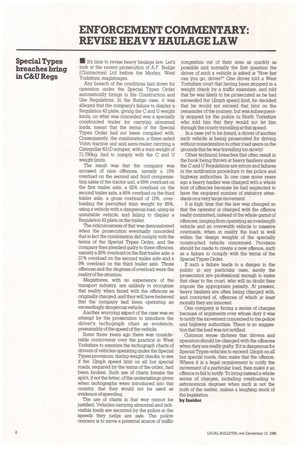Special Types breaches bring in C&U Regs
Page 20

If you've noticed an error in this article please click here to report it so we can fix it.
• It's time to revise heavy haulage law. Let's look at the recent prosecution of A. F. Budge (Contractors) Ltd before the Morley, West Yorkshire, magistrages.
Any breach of the conditions laid down for operation under the Special Types Order automatically brings in the Construction and Use Regulations. In the Budge case, it was alleged that the company's failure to display a Regulation 42 plate, giving the C and U weight limits, on what was conceded was a specially constructed trailer for carrying abnormal loads, meant that the terms of the Special Types Order had not been complied with. Consequently, the combination, a three-axled Volvo tractive unit and semi-trailer carrying a Caterpillar 631D scraper, with a train weight of 71,790kg, had to comply with the C and U weight limits.
The result was that the company was accused of nine offences, namely a 15% overload on the second and third compensating axles of the tractor unit, a 69% overload on the first trailer axle, a 62% overload on the second trailer axle, a 46% overload on the third trailer axle, a gross overload of 15%, overloading the permitted tram weight by 89%, using a vehicle with a dangerous load, using an unsuitable vehicle, and failing to display a Regulation 42 plate on the trailer.
The ridiculousness of that was demonstrated when the prosecution eventually conceded that in fact the combination did comply with the terms of the Special Types Order, and the company then pleaded guilty to three offences, namely a 26% overload on the first trailer axle, a 21% overload on the second trailer axle and a 9% overload on the third trailer axle. Those offences and the degrees of overload were the reality of the situation.
Magistrates, with no experience of the transport industry, are unlikely to recognise that reality when faced with the offences as originally charged, and they will have believed that the company had been operating an exceedingly dangerous vehicle.
Another worrying aspect of the case was an attempt by the prosecution to introduce the driver's tachograph chart as evidence, presumably of the speed of the vehicle.
Some three years ago there was considerable controversy over the practice in West Yorkshire to examine the tachograph charts of drivers of vehicles operating under the Special Types provisions, during weight checks, to see if the 12mph speed limit on all but special roads, required by the terms of the order, had been broken. Such use of charts breaks the spirit, if not the letter, of the undertakings given when tachographs were introduced into this country, that they would not be used as evidence of speeding.
The use of charts in that way cannot be justified. Vehicles carrying abnormal and indivisible loads are escorted by the police at the speeds they judge are safe. The police concern is to move a potential source of traffic congestion out of their area as quickly as possible and normally the first question the driver of such a vehicle is asked is "How fast can you go, driver?" One driver told a West Yorkshire court that having been stopped in a weight check by a traffic examiner, and told that he was likely to be prosecuted as he had exceeded the 12mph speed limit, he decided that he would not exceed that limit on the remainder of the journey, but was subsequently stopped by the police in North Yorkshire who told him that they would not let him through the county travelling at that speed.
In a case yet to be heard, a driver of another such vehicle is being prosecuted for driving without consideration to other road users on the grounds that he was travelling too slowly!
Other technical breaches that often result in the book being thrown at heavy hauliers under the C and U Regulations are errors and failures in the notification procedure to the police and highway authorities. In one case some years ago a heavy haulier was charged with a whole host of offences because he had neglected to have the required number of statutory attendants on a very large movement.
It is high time that the law was changed so that the operator is charged with the offence really committed, instead of the whole gamut of offences, ranging from operating an overlength vehicle and an overwidth vehicle to massive overloads, when in reality the load is well within the design weights of the specially constructed vehicle concerned. Provision should be made to create a new offence, such as a failure to comply with the terms of the Special Types Order.
If such a failure leads to a danger to the public in any particular case, surely the prosecution are professional enough to make that clear to the court, who will no doubt then impose the appropriate penalty. At present, heavy hauliers are often being charged with, and convicted of, offences of which at least morally they are innocent.
One company is facing a series of charges because of arguments over whose duty it was to notify the movement concerned to the police and highway authorities. There is no suggestion that the load was not notified Common sense dictates that drivers and operators should be charged with the offences when they are really guilty. If it is dangerous for Special Types vehicles to exceed 12mph on all but special roads, then make that the offence. Where it is a legal requirement to notify the movement of a particular load, then make it an offence to fail to notify. To bring instead a whole series of charges, including overloading to astronomical degrees when such is not the truth of the matter, makes a laughing stock of the legislation.
by Insider














































































































